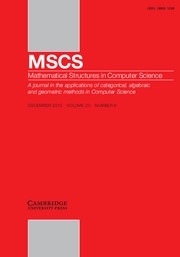Article contents
Introduction to linear bicategories
Published online by Cambridge University Press: 01 April 2000
Abstract
Linear bicategories are a generalization of bicategories in which the one horizontal composition is replaced by two (linked) horizontal compositions. These compositions provide a semantic model for the tensor and par of linear logic: in particular, as composition is fundamentally non-commutative, they provide a suggestive source of models for non-commutative linear logic.
In a linear bicategory, the logical notion of complementation becomes a natural linear notion of adjunction. Just as ordinary adjoints are related to (Kan) extensions, these linear adjoints are related to the appropriate notion of linear extension.
There is also a stronger notion of complementation, which arises, for example, in cyclic linear logic. This sort of complementation is modelled by cyclic adjoints. This leads to the notion of a *ast;-linear bicategory and the coherence conditions that it must satisfy. Cyclic adjoints also give rise to linear monads: these are, essentially, the appropriate generalization (to the linear setting) of Frobenius algebras and the ambialgebras of Topological Quantum Field Theory.
A number of examples of linear bicategories arising from different sources are described, and a number of constructions that result in linear bicategories are indicated.
- Type
- Research Article
- Information
- Copyright
- © 2000 Cambridge University Press
- 15
- Cited by


